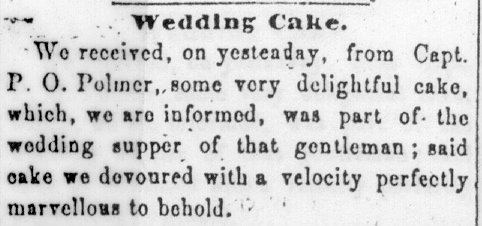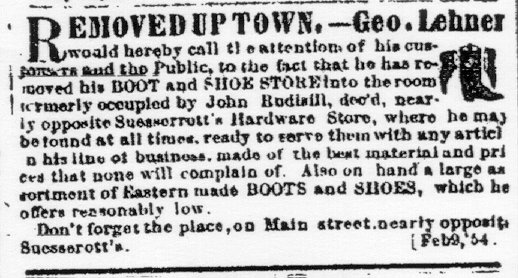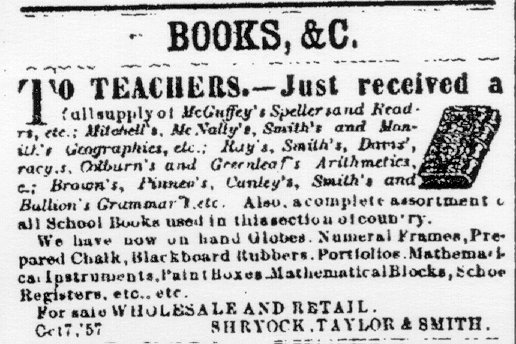| Staunton Spectator | Chambersburg Valley Spirit |
| Staunton Vindicator | Franklin Repository and Transcript |
|
Visiting the United States in the 1860s, Briton Edward Dicey remarked that "the American might be defined as a newspaper-reading animal." Indeed, the 1860 census reported that there were 4,051 newspapers and periodicals published in the United States with a total circulation of 928 million, or 34 for every free person in the country. Daily newspapers in Northern urban areas such as New York, Boston, and Philadelphia accounted for a significant proportion of this total, but by the 1850s many small towns across the United States had at least one weekly newspaper. Local newspapers were important informative links for citizens of the Great Valley, both to others in their counties as well as to events, politics, and changes occurring elsewhere. The papers of the nineteenth century, however, may be an even more important source of information for those of us investigating the past than they were for those who lived in it. In the nineteenth century, as today, individuals shared information in many nonliterate and informal ways--by word of mouth in the church, the household, the workplace. For the most part, the information passed by those networks is lost to us. But a careful reading of the newspapers of Franklin and Augusta counties helps the twentieth-century historian develop a familiarity with the politics, commerce, and events of daily life in these nineteenth-century communities. In addition, by paying attention to the extralocal news printed in the papers, one can see the links of the local to the regional, national, and international scenes. As the Southern Quarterly Review noted as early as 1843: Men knew little, formerly, of what was passing beyond . . . their own immediate neighborhood, but now, through the . . . newspapers . . . , town and country, state and nation, and the most distant parts of the world are brought together, and whatever is new, rare and important, is conveyed with rapidity to every reader . . . set forth in the most succinct manner, and in a style adapted to the comprehension of all.The newspapers help us know, at least in part, what those reading them knew about their own environments. You can use this understanding to imagine, perhaps, how a farmer or merchant reading his weekly paper may have used the information it contained to situate himself in his community, his state, his country, and his world.
The appearance and content of newspapers of the mid-nineteenth century were very different from our own. On first glance they can seem to be merely column after column of undifferentiated text.
However, just as our own newspapers have predictable layouts, section divisions, and so on, so did papers of the nineteenth century. The following is designed as a primer on newspapers of the period, and as an introduction to what one might expect to find in a typical issue of each of the four newspapers represented in the Valley of the Shadow: the Staunton Spectator and the Staunton Vindicator from Augusta County, and the Chambersburg Valley Spirit and the Franklin Repository and Transcript from Franklin County.
To the modern reader, the most unusual feature of
nineteenth-century newspapers is the layout. In a typical modern
daily, articles can span a number of columns, are frequently situated
in the middle of a page, and have large multiple-column headlines
(strategically positioned by the editors to appear above or below the
fold of the paper). In nineteenth-century papers, however, a page of
text simply began with an item in the upper left hand corner and read
down the column until its conclusion, marked by a single line,
whereupon the next item began. This pattern continued, with the paper
designed to be read from top to bottom, column by column, across the
page. With the exceptions of proceedings of state or national
legislatures, conventions such as church conferences or nominating
conventions for political parties, published speeches, and selections
of fiction, items rarely ran more than a single column in length.
Headlines, when they appeared at all, were never more than a single
column in width (this was the case even when the item being headlined
spanned multiple columns) and were generally printed in boldface, with
the type just slightly larger than that of the item's text.
Only on very rare and special occasions, such as
elections and important public gatherings, were headlines extraordinarily
large or containing one or more smaller "subheadlines."
It would be unheard of for a newspaper today to publish
without photographs, but another obvious feature of nineteenth-century
papers is their almost complete lack of graphic display. Printing
technology made it impossible for papers to reproduce photographs.
Some of the largest and most profitable urban dailies of the period
published stories with illustrations in the form of printed woodcuts.
Advertisements rather than subscriptions paid most of a newspaper's expenses.
Therefore, ads were coveted by publishers and often occupied half, if not more, of the space in any given issue. When looking for information about the past, however, one should not ignore advertisements as "non-news" items. Advertisements describe upcoming local events and announce land sales and public auctions, marriages and deaths, market prices, church services, school graduations and picnics, and militia gatherings. With such important information embedded in their columns, ads were read as "news" by contemporaries and should be read as such by the modern researcher. They provide a sense for the social life of a community, as well as for its commercial and consumer activities, in ways more conventional news items often do not. As Frederic Hudson, managing editor of the New York Herald, wrote in 1872 in a statement as applicable to the small town as to the large city: The advertisements form the most interesting and practical city news. They are the hopes, the thoughts, the joys, the plans, the shames, the losses, the mishaps, the fortunes, the pleasures, the miseries, the politics, and the religion of the people. Each advertiser is therefore a reporter, a sort of penny-a-liner, he paying the penny. What a picture . . . one day's advertisements . . . presents to mankind! For the reader accustomed to the modern journalist's pretense to "objectivity" in reporting, the writing style of a nineteenth-century editor likely will be somewhat jarring. It never would have occurred to most editors in the nineteenth century to publish an "objective" news story, nor would they have seen the value in doing so had it been suggested to them. Newspapers of the nineteenth century were overtly partisan, in the belief that a newspaper's mission was to promote the line of a particular political party, to help maintain and support that party's organization and activities on the local level, and to work to get that party's candidates elected to public offices at all levels. In the eighteenth and into the early nineteenth century, it was common practice for a newspaper to receive funding directly from a political party. During the first quarter of the nineteenth century, editors began asserting the need for an "independent" press, and by the time of the Civil War, most newspapers did in fact claim to be politically "independent." All that "independence" actually meant, however, was that the paper no longer received financial assistance directly from, and was no longer formally affiliated with, a political party. Papers continued to reflect the political positions of the editor and his party (the 1850 census credited just 5 percent of the nation's newspapers with being "neutral" or "independent."). Editors often ridiculed the opposition (when not ignoring it altogether), and editorial wars between rival newspapermen in a city or town were common and sometimes very heated, occasionally to the point of violence. For his own defense, the wise editor in the nineteenth century carried a thick cane or a gun when walking the streets. Most newspapers outside large urban areas could not afford to maintain a staff of traveling correspondents to perform tasks of reporting or investigative journalism. Neither did small weeklies have sole or unlimited access to telegraph lines. Thus, it was standard and accepted practice for editors to acquire many, if not most, of their extralocal news stories from other newspapers published around the country with which they reciprocated subscriptions.
An editor read the papers he received through this system of newspaper "exchange," selected those stories he deemed of interest, and then reprinted them in his own paper, indicating the original source with a line of attribution. This system of news reception and exchange had significant consequences for the content of town newspapers. Information about the most objectively significant national events (e.g., a presidential election, the outbreak of the Civil War), might be received by telegraph. But for most events, because town newspapers only published weekly and because mail delivery from distant locales might take a week or more, reports of happenings outside the immediate vicinity of a newspaper's readership might not appear until a number of weeks after they actually occurred. In addition, because of the partisan nature of the nineteenth-century press, an editor would likely only "exchange" subscriptions with other newspapers of his own party. Thus, while a town newspaper brought its readers news of the world outside their neighborhood, the extralocal events recorded in a local newspaper did not necessarily present a national picture. Rather, theirs was a particularly Whig, Republican, or Democratic view of national events. Indeed, it can seem that papers publishing in the same town are reporting the news of two different, if related, countries. Though less pervasive, such a disparity even manifested itself at the local level, especially with respect to local politics. One paper might announce and describe local Whig meetings, while the other would do the same for local Democrats, with each almost completely ignoring the presence and activities of the opposition. The practice of newspaper exchanges also allowed editors to fill their pages with sensational pieces, much like examples of today's tabloid journalism. These pieces were apolitical, concentrating instead on tales of interracial elopements or physical oddities like two-headed calves, and thus appeared in newspapers regardless of partisan affiliation. One cautionary note on the content of nineteenth-century newspapers. Cultural norms of the nineteenth century, especially attitudes toward race, ethnicity, and gender, often differed, sometimes greatly and surprisingly, from our own. Demeaning descriptions of African-Americans (not to mention advertisements for slave auctions) frequently appeared in the weekly paper, and one will rarely see any women named specifically in print (speaking directly about a lady was considered in poor taste). The modern reader must be constantly aware that compared to our own, the cultural context of the nineteenth century was far more caustic in some ways and more decorous in others.
While all the newspapers available in the Valley of the Shadow demonstrate the general characteristics described above, each paper also has its own individual style. To facilitate the use of the Spectator, Valley Spirit, Repository, and Vindicator, one issue of each paper is analyzed below in terms of layout and content. To make comparisons between the papers more obvious, all the issues are of the same week of publication--the week of January 30, 1860.
|


 Town newspapers, however, had comparatively small circulations and
comparatively small budgets. They rarely had the funds to produce a
graphic of any sort. Advertisers did sometimes pay for an image to
appear with their insert. For the most part, these images were small
woodcuts reflecting the product for sale or the subject of the
advertisement. A graphic of a shoe might accompany
an ad for a shoe store,
or a graphic of a book might appear alongside an
insert promoting the services of a bindery.
Town newspapers, however, had comparatively small circulations and
comparatively small budgets. They rarely had the funds to produce a
graphic of any sort. Advertisers did sometimes pay for an image to
appear with their insert. For the most part, these images were small
woodcuts reflecting the product for sale or the subject of the
advertisement. A graphic of a shoe might accompany
an ad for a shoe store,
or a graphic of a book might appear alongside an
insert promoting the services of a bindery.

